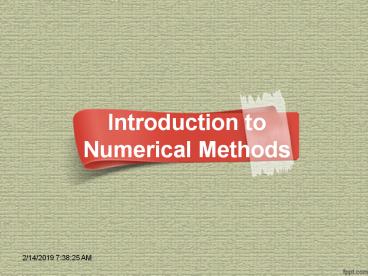Introduction on Numerical methods - PowerPoint PPT Presentation
Title:
Introduction on Numerical methods
Description:
Mathematics-IV for BPUT students. – PowerPoint PPT presentation
Number of Views:167
Updated: 10 March 2014
Slides: 17
Provided by:
anil.anisrav
Category:
How To, Education & Training
Tags:
Title: Introduction on Numerical methods
1
Introduction to Numerical Methods
2
Introduction
- Numerical methods are the techniques by which
mathematical problems are formulated. So that
they can solved with arithmetic operations. - A class of methods for solving a wide variety of
mathematical problems like non-linearites,
complex and large system of coupled equations of
many real world physical situations that often
impossible to solve analytically. - These methods are easy to implement directly on
digital computers.
3
Introduction(Continue.)
- Engineering problems frequently arise in which
exact analytical solutions are not available.
Approximate solutions are normally sufficient for
engineering applications, allowing the use of
approximate numerical methods. - The development of Numerical methods is happened
due to powerful computers. At the same time the
power and limitation of a computer are
illustrated by the implementation of Numerical
methods in computers.
4
Introduction(Continue.)
- Selected Categories of Numerical Methods and
Applications. - Linearization
- Finding Roots of Functions
- Solving Systems of Equations
- Optimization
- Numerical Integration and Differentiation.
- Numerical methods involves the operations on
numbers. - Numerical methods gives the result in approximate
manner.
5
Number system. Decimal number system
The decimal number system has the base or radix
10.That means it uses the digits
0,1,2,3,4,5,6,7,8,9 to represent every number.
In general decimal number is represented as
Where dis and fis are decimal digits
6
Examples
7
Number system. Binary number system
The binary number system has base two and it is
consists of two digits 0 and 1 . Any binary
number can be expressed by the help of these two
digits.
In general these are represented as
Where dis and fis are binary digits
8
Examples
- (11011)2,(101.110)2 are binary numbers.
9
Number system. Octal number system
The octal number system has base 8 and it
consists of eight digits 0,1,2,3,4,5,6 and 7.
Any octal number can be expressed by the help of
these eight digits.
In general these are represented as
Where dis and fis are octal digits
10
Example
11
Number system. Hexadecimal number system
The Hexadecimal number system has base 16 and it
consists of sixteen characters 0,1,2,3,4,5,6,7,8,9
,A,B,C,D,E,F. Any Hexadecimal number can be
expressed by the help of these sixteen
characters. Where A,B,C,D,E,F are
10,11,12,13,14,15.
In general these are represented as
Where dis and fis are hexadecimal digits
12
Example.
- (2A4.F5)16, (2.5D)16 are hexadecimal numbers.
13
Conversion of Decimal to Binary
2 15 1
2 7 1
2 3 1
1
0.25 ? 2 0.50
0.50 ? 2 1.00
(15)10(1111)2
(0.25)10(.01)2
(15.25)10(1111.01)2
14
Conversion of Decimal to Octal
8 135 7
8 16 0
2
0.3125 ? 8 2.5000
0.5000 ? 8 4.0000
(135)10(207)8
(0.3125)10(.24)8
(135.3125)10(207.24)8
15
Conversion of Decimal to Hexadecimal
16 214 6
13
0.03125 ? 16 0.50000
0.50000 ? 16 8.0000
13?D
(214)10(D6)16
(0.03125)10(.08)16
(214.03125)10(D6.08)16
16
Thank You ALL
- Presented by
- Boina Anil Kumar
- Asst.Prof in Mathematics
- MITS, Rayagada.
- Odisha, India
- E-mail anil.anisrav_at_gmail.com
- Visit at http//www.mits.edu.in/academics.phpfac
ulty_BSH-tab

